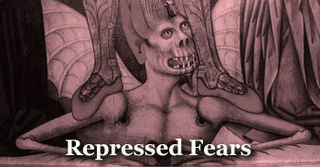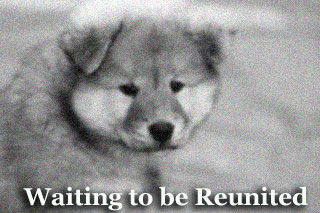Fear
The Uncanny Fear of Loss, Part 3
Part 3: Attachment, Mental Climate, and Loss
Posted May 30, 2018
This is our third and final entry in the series about loss.
A Summary of the Fear of Loss
In this three-part series, we’ve wondered why we're afraid of losing things we're going to lose anyway (Part 1). We’ve wondered why we're afraid of being forgotten, instead of noticing each other right now (Frankl, 1990). And we’ve wondered why what we’ve lost refuses to go away completely, lingering in our memories as though terrified of being forgotten (Part 2).
This time, in this final entry, we will ask if these reminders that just won't go away aren't just reminders. Maybe thoughts act as things, while genuine things are absent (Mulford, 2013). And maybe the symbols of things we loved too much to lose have gotten used to being symbols of things we love and don’t want us to stop needing them? Just maybe this mental activity does not want to stop being what it’s been for so long and risk representing something dull instead of dear. We do seem to cherish and defend our thoughts, sometimes more than the living things those thoughts represent (Meinecke, 2017).

Maybe Thoughts Are Afraid to Perish
Challenge your thinking. Maybe, like any primary attachment, this mental activity inside needs to be needed too, once it has been needed and loved for so long and so often? The loss of (or failure to find) a primary attachment is serious and often traumatic. Maybe this is true even at the cellular level? Neurons behave an awful lot like people exposed to neglect and trauma (Gerstner, Kistler, Naud, & Paninski, 2014). Imagine you’re desperately in need of continuing care and affection — and have just found out you never will be loved or cared for again (Bowlby, 1982). Orphans know this feeling all too well. Maybe there are orphan cells inside of orphaned people, and all we see is the vessel rather than the pilot.
Carl Jung wrote that sometimes he felt as if his memories were deliberately avoiding him … teasing him like a jealous and flirtatious lover (Jung & Jaffé, 1963). If this sounds hard to accept, remember that neurons are living things in a living person — living cells that have been exposed to both wonderful and terrible events while they lived. A living brain is not a set of lifeless transistors on a lifeless circuit board, charged with remembering arbitrary details while ignoring everything else.
Curiously, Nobel prize winners Hubel and Wiesel found something similar (and very uncanny) when they experimented on eye neurons. They left them with no purpose ... yet those neurons exhibited a desperate will to find one worth living for anyway (Wiesel, 1982). Just maybe the living cells we use to notice things with (and to remember where things used to be) eventually become accustomed to our need for their help? We do know that what’s no longer needed by the body is often denied resources and left to wither. So, even if the things we miss are missing, the things we miss things with are still here, needing someone to use them or else (Ramachandran, 2012).
This, at least, accords very well with Piaget’s object permanence concept (the learned ability to believe in things which can't be seen anymore). It also aligns with V.S. Ramachandran’s work on phantom limb syndrome — how just seeing a ghostly reflection of your lost hand can reduce the horrible pain of a missing limb (Ramachandran, 2012; Ramachandran, Rogers-Ramachandran, & Cobb, 1995).
Thoughts Are Like Mental Affection
I’m going to leave you with this thought. What if the same memories that comfort us after our loved ones die envy our loved ones before they die? Maybe this living nervous system and its restless mental activity find meaning and purpose in taking the place of things we couldn’t bear losing? Now those physical reminders we can no longer touch will become internal reminders that will never abandon us. Thoughts keep us company, while we await the return of things we will never meet again (Klass, 1993). Ainsworth helped us see that we aren't born certain that our primary attachment will return. We just learn to expect that through learned reinforcement and parental synchrony (Bernard, Meade, & Dozier, 2013).

Emotions Are Like a Mental Climate
And just as our memories seem to act like inner actors on an inner stage, it’s hard not to notice how our emotions act a lot like an inner climate of an inner world. Sometimes it feels like a storm is brewing inside (anger). Other times, the sun seems to come out after a dark and gloomy day (joy).
Is it just an accident that when someone puts a blanket over our doll, we still know our doll is there beneath that blanket? Because this same learning is how we can stay calm when Mom goes to work in the morning, since a voice inside says Mom will be back at the end of the day (Baillargeon, Spelke, & Wasserman, 1985). Maybe Mom’s familiar voice is still here in our neurons, whispering, “I’ll be back soon,” when the rest of us is about to cry.
Ask yourself this: What if expectations aren't something we acquire or learn, but are much more like forming an attachment or preference? Maybe these expectations we hold dear in our hearts — and which linger as hope in our heads — keep us company until we are together again with the genuine outer stimuli we can't bear being apart from? You see, if one of us should perish first, a hundred years is an awfully long time to wait to see each other again.

References
Baillargeon, R., Spelke, E. S., & Wasserman, S. (1985). Object permanence in five-month-old infants. Cognition, 20(3), 191-208. https://doi.org/10.1016/0010-0277(85)90008-3
Bernard, K., Meade, E. B., & Dozier, M. (2013). Parental synchrony and nurturance as targets in an attachment-based intervention: Building upon Mary Ainsworth’s insights about mother–infant interaction. Attachment & Human Development, 15(5-6), 507-523. https://doi.org/10.1080/14616734.2013.820920
Bowlby, J. (1982). Attachment and loss: Retrospect and prospect. American Journal of Orthopsychiatry, 52(4), 664-678. http://dx.doi.org/10.1111/j.1939-0025.1982.tb01456.x
Frankl, V. (1990). Facing the transitoriness of human existence. Generations, 14(4), 7. Available at: http://www.asaging.org/generations-journal-american-society-aging
Gerstner, W., Kistler, W. M., Naud, R. & Paninski, L. (2014). Neuronal dynamics: From single neurons to networks and models of cognition. Cambridge, England: Cambridge University Press.
Jung, C. G, & Jaffé, A. (1963). Memories, dreams, reflections [Kindle ed.]. New York, NY: Crown Publishing Group/Random House.
Klass, D. (1993). Solace and immortality: Bereaved parents’ continuing bond with their children. Death Studies, 17(4), 343-368. https://doi.org/10.1080/07481189308252630
Meinecke, L. D. (2017). Neglected by assessment: Industry versus inferiority in the competition for scarce kidneys. (Doctoral dissertation). Grand Canyon University, Arizona.
Mulford, P. (2013). Thoughts are things. Lanham: Start Publishing LLC.
Ramachandran, V. S. (2012). The tell-tale brain: A neuroscientist's quest for what makes us human. New York, NY: W. W. Norton and Company.
Ramachandran, V. S., Rogers-Ramachandran, D., & Cobb, S. (1995). Touching the phantom limb. Nature, 377(6549), 489-490. doi: http://dx.doi.org/10.1038/377489a0
Wiesel, T. N. (1982). The postnatal development of the visual cortex and the influence of environment. Bioscience Reports, 2(6), 351-377. Retrieved from http://www.nobelprize.org/nobel_prizes/medicine/laureates/1981/wiesel-lecture.pdf




